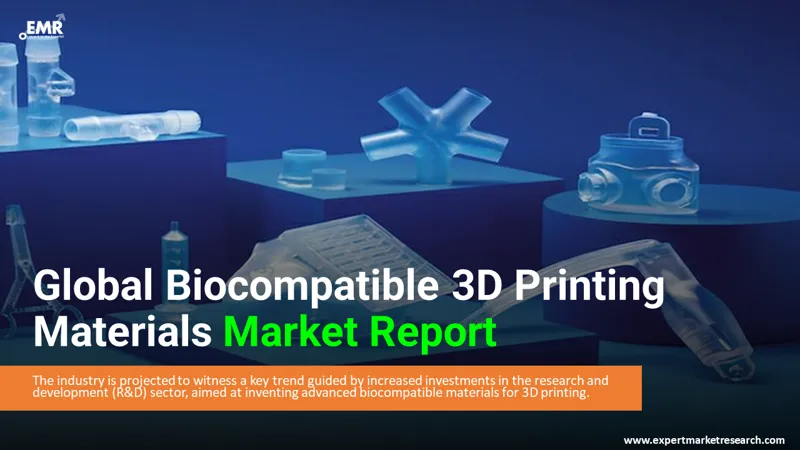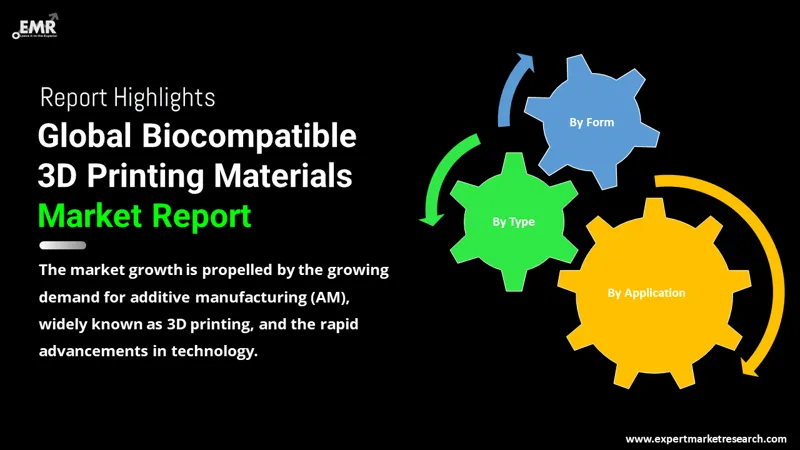
Consumer Insights
Uncover trends and behaviors shaping consumer choices today
Procurement Insights
Optimize your sourcing strategy with key market data
Industry Stats
Stay ahead with the latest trends and market analysis.
The global biocompatible 3D printing materials market was valued at USD 895.80 Million in 2025. The industry is expected to grow at a CAGR of 20.00% during the forecast period of 2026-2035 to attain a valuation of USD 5546.56 Million by 2035.
Base Year
Historical Period
Forecast Period
Compound Annual Growth Rate
20%
Value in USD Million
2026-2035
*this image is indicative*
The rising preference for additive manufacturing is one of the major factors driving the growth of the biocompatible 3D printing materials industry. The increasing demand for silicone in additive manufacturing owing to its sustainable and biocompatible nature is expected to provide a further boost to the industry as it offers flexibility in product design.

Read more about this report - REQUEST FREE SAMPLE COPY IN PDF
The biocompatible 3D printing materials industry can be divided into segments like type, application, and form.
Based on its application, the market can be segmented into:
Based on its form, the market can be divided into:
Based on its type, the market can be categorised as:
The regional markets for biocompatible 3D printing materials like:

Read more about this report - REQUEST FREE SAMPLE COPY IN PDF
The growing demand for additive manufacturing is one of the key factors contributing to the development of the biocompatible 3D printing materials industry. The demand for additive manufacturing is growing as it is used to produce complex components in the healthcare industry due to its flexible nature.
The powder is the leading segment in the global market for biocompatible 3D printing materials. The powder form is compatible with many 3D printers and is therefore used in medical applications such as implants and prostheses, tissue engineering, and surgical tools. Silicone is becoming increasingly popular as a raw material for the additive manufacturing of medical products owing to its chemical resistant properties and flexibility. The use of biocompatible 3D materials also reduces assembly time and wastage of material; thus, minimising production cost of components. This, coupled with the increased investment in the R&D sector to invent other advanced biocompatible 3D printing materials, is expected to impact the market positively during the forecast period.
The report presents a detailed analysis of the following key players in the global biocompatible 3D printing materials industry, looking into their capacity, competitive landscape, and latest developments like capacity expansions, plant turnarounds, and mergers and acquisitions:
The EMR report gives an in-depth insight into the industry by providing a SWOT analysis as well as an analysis of Porter’s five forces.




*While we strive to always give you current and accurate information, the numbers depicted on the website are indicative and may differ from the actual numbers in the main report. At Expert Market Research, we aim to bring you the latest insights and trends in the market. Using our analyses and forecasts, stakeholders can understand the market dynamics, navigate challenges, and capitalize on opportunities to make data-driven strategic decisions.*
Get in touch with us for a customized solution tailored to your unique requirements and save upto 35%!
In 2025, the global biocompatible 3D printing materials market attained a value of nearly USD 895.80 Million.
The market is estimated to witness a healthy growth, expanding at a CAGR of 20.00% between 2026 and 2035.
The major drivers of the market include the growing demand for additive manufacturing (AM), also known as 3D printing, and the rapid technological advancements.
The increased investment in the R&D sector to invent other advanced biocompatible 3D printing materials is expected to be a key trend guiding the growth of the industry.
The major regions in the industry are North America, Latin America, the Middle East and Africa, Europe, and the Asia Pacific.
Polymer, and metal, among others are the different types of the product in the market.
Powder, and liquid, among others are the significant forms of the product in the market.
Implants and prosthesis, prototyping and surgical guides, tissue engineering, and hearing aid, among others are the various applications of the product.
The major players in the industry are 3D Systems, Inc., Evonik Industries AG, Stratasys Ltd., General Electric Company (Concept Laser GmbH), Renishaw, Aspect Biosystems Ltd., and Detax Ettlingen, among others.
Explore our key highlights of the report and gain a concise overview of key findings, trends, and actionable insights that will empower your strategic decisions.
| REPORT FEATURES | DETAILS |
| Base Year | 2025 |
| Historical Period | 2019-2025 |
| Forecast Period | 2026-2035 |
| Scope of the Report |
Historical and Forecast Trends, Industry Drivers and Constraints, Historical and Forecast Market Analysis by Segment:
|
| Breakup by Type |
|
| Breakup by Form |
|
| Breakup by Application |
|
| Breakup by Region |
|
| Market Dynamics |
|
| Competitive Landscape |
|
| Companies Covered |
|
| Report Price and Purchase Option | Explore our purchase options that are best suited to your resources and industry needs. |
| Delivery Format | Delivered as an attached PDF and Excel through email, with an option of receiving an editable PPT, according to the purchase option. |
Datasheet
One User
USD 2,499
USD 2,249
tax inclusive*
Single User License
One User
USD 3,999
USD 3,599
tax inclusive*
Five User License
Five User
USD 4,999
USD 4,249
tax inclusive*
Corporate License
Unlimited Users
USD 5,999
USD 5,099
tax inclusive*
*Please note that the prices mentioned below are starting prices for each bundle type. Kindly contact our team for further details.*
Flash Bundle
Small Business Bundle
Growth Bundle
Enterprise Bundle
*Please note that the prices mentioned below are starting prices for each bundle type. Kindly contact our team for further details.*
Flash Bundle
Number of Reports: 3
20%
tax inclusive*
Small Business Bundle
Number of Reports: 5
25%
tax inclusive*
Growth Bundle
Number of Reports: 8
30%
tax inclusive*
Enterprise Bundle
Number of Reports: 10
35%
tax inclusive*
How To Order

Select License Type
Choose the right license for your needs and access rights.

Click on ‘Buy Now’
Add the report to your cart with one click and proceed to register.

Select Mode of Payment
Choose a payment option for a secure checkout. You will be redirected accordingly.
Gain insights to stay ahead and seize opportunities.

Get insights & trends for a competitive edge.

Track prices with detailed trend reports.

Analyse trade data for supply chain insights.

Leverage cost reports for smart savings

Enhance supply chain with partnerships.

Connect For More Information
Our expert team of analysts will offer full support and resolve any queries regarding the report, before and after the purchase.
Our expert team of analysts will offer full support and resolve any queries regarding the report, before and after the purchase.
We employ meticulous research methods, blending advanced analytics and expert insights to deliver accurate, actionable industry intelligence, staying ahead of competitors.
Our skilled analysts offer unparalleled competitive advantage with detailed insights on current and emerging markets, ensuring your strategic edge.
We offer an in-depth yet simplified presentation of industry insights and analysis to meet your specific requirements effectively.
Share